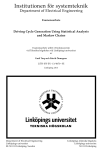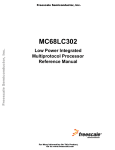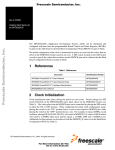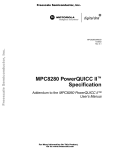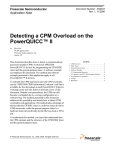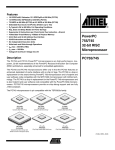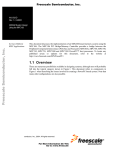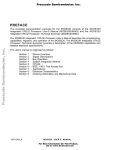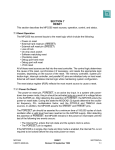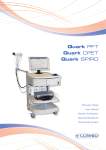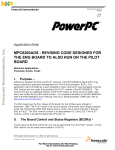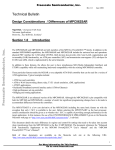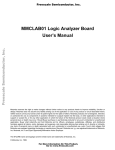Download AN2290 MPC8260 PowerQUICC II Design Checklist
Transcript
Freescale Semiconductor Application Note Document Number: AN2290 Rev. 2, 02/2006 MPC8260 PowerQUICC™II Design Checklist NCSG Field Applications Boston, MA This document provides recommendations for designs based on devices of the PowerQUICC™ II family of integrated communications processors (collectively referred to throughout this document as the MPC8260). The family includes the following devices: Table 1. PowerQUICC II Family Process Technology Devices 0.29µm (HiP3) • MPC8260 • MPC8255 0.25µm (HiP4) • MPC8260A • MPC8250A • MPC8255A • MPC8264A • MPC8265A • MPC8266A Refer to Section 10, “References,” to review the available information on the functionality, characteristics, and silicon revisions for each device. This document may also be useful in debugging newly designed systems by highlighting those aspects of a design that merit special attention during initial system startup. © Freescale Semiconductor, Inc., 2004, 2006. All rights reserved. 1 2 3 4 5 6 7 8 9 10 11 Contents Getting Started . . . . . . . . . . . . . . . . . . . . . . . . . . . . . . .2 Power . . . . . . . . . . . . . . . . . . . . . . . . . . . . . . . . . . . . . .4 Clocks . . . . . . . . . . . . . . . . . . . . . . . . . . . . . . . . . . . . . 7 Reset. . . . . . . . . . . . . . . . . . . . . . . . . . . . . . . . . . . . . . . 8 Bit and Byte Lane Ordering . . . . . . . . . . . . . . . . . . . . .9 External Signals . . . . . . . . . . . . . . . . . . . . . . . . . . . . .12 Memory and Cache . . . . . . . . . . . . . . . . . . . . . . . . . . .13 COP/JTAG Interface . . . . . . . . . . . . . . . . . . . . . . . . . .14 Signal States and Terminations . . . . . . . . . . . . . . . . . .16 References . . . . . . . . . . . . . . . . . . . . . . . . . . . . . . . . . .22 Revision History . . . . . . . . . . . . . . . . . . . . . . . . . . . . .23 Getting Started 1 Getting Started This section describes how to simplify the first phase of design. Before designing a system with a PowerQUICC II device, become familiar with the available documentation, silicon revisions, software, microcodes, models, and tools available at the web site listed on the back cover of this document. Refer to Section 10, “References.” 1.1 CPM Performance and Bus Usage The PowerQUICC II CPM runs by time-sharing multiple communication protocols. To estimate the CPM load factor for a particular combination of protocols, use the MPC8260 CPM Performance Evaluator tool (the link “MPC8260SW03.zip” appears in the “Software” table on the MPC8260 product page at the Freescale web site). This tool also estimates the 60x and local bus loads for the combination of protocols selected, bus frequencies, memory speeds, and placement of data structures. At startup, the tool initializes all parameters with default values that are not the recommended values. These values must be changed for each application. 1.2 Pin Assignments The on-chip serial communications peripherals use four 32-bit parallel ports to exchange data with the physical interfaces. On each pin of the parallel ports several signals are multiplexed. If none of the signals on a given pin are necessary for an application, the pin can be used as an I/O port. To verify the availability of the I/O functions chosen through pin multiplexing, use the MPC8260 Parallel Ports Configuration tool (the link “MPC8260SW02.zip” appears in the “Software” table on the MPC8260 product page at the Freescale web site). After you select the signals required by an application, this utility assists in defining the pin configuration of each parallel port. A report can then be generated that includes all selections and C-initialization code for the registers associated with the parallel ports. 1.3 Reset Configuration Word After deciding on the pin multiplexing, review the hard reset configuration word for multiplexing selection and system design decisions (single MPC8260 bus mode versus 60x–compatible bus mode, boot port size, and so on.). The hardware reset configuration word is described in Table 2. Table 2. Hard Reset Configuration Word Bits Name Description Comments 0 EARB Bus arbitration 0 Internal 1 External 1 EXMC Memory controller 0 Internal 1 External 2 CDIS Core 0 Enabled 1 Disabled 3 EBM External bus mode 0 Single MPC8260 bus mode 1 60x-compatible bus mode MPC8260 PowerQUICC™II Design Checklist, Rev. 2 2 Freescale Semiconductor Getting Started Table 2. Hard Reset Configuration Word (continued) Bits Name Description Comments 4–5 BPS Boot port size 00 64-bit 01 8-bit 10 16-bit 11 32-bit 6 CIP Core initial prefix 0 0xFFFn_nnnn 1 0x000n_nnnn 7 ISPS Internal space port size 0 64-bit 1 32-bit 8–9 L2CPC L2 cache configuration 00 CI, WT, L2_HIT, CPU_BG active 01 IRQ2, IRQ3, IRQ4, IRQ5 active 10 BADDR(29), BADDR(30), BADDR(31) active 10–11 DPPC Data parity pin configuration 00 IRQ1-7 active 01 DP(0-7) active 10 RSRV, IRQ1, TLBISYNC, CKSTP_OUT, CORE_SRESET, TBEN, CSE(0), CSE(1) active 11 Additional arbitration lines and IRQ6,7 active 12 — Reserved — 13–15 ISB Initial address of internal RAM 000 0x0000_0000 001 0x00F0_0000 010 0x0F00_0000 011 0x0FF0_0000 100 0xF000_0000 101 0xF0F0_0000 110 0xFF00_0000 111 0xFFF0_0000 IMMR[0-14] 16 BMS Boot memory space 0 HIMEM: 0xFE00_0000–0xFFFF_FFFF 1 LOMEM: 0x0000_0000–0x01FF_FFFF 17 BBD Bus busy 0 Enabled. ABB and DBB active. 1 Disabled. IRQ2 and IRQ3 active. 18–19 MMR Mask masters requests 00 No masking on bus request lines 10 Boot master connected to EXT_BR1 11 All external bus requests masked 20–21 LBPC Local bus pin configuration 00 Local bus pins function as local bus 10 Local bus pins function as core pins 22–23 APPC Address parity pin configuration 00 TC(0-2), IRQ7/INT_OUT, CS11 active 01 AP(0-3), APE active 10 BNKSEL(0-2), IRQ7/INT_OUT active 11 IRQ7/INT_OUT active 24–25 CS10PS CS10 pin configuration 00 CS10 active 01 BCTL1 active 10 DBG_DIS active 26–27 — Reserved — 28–31 MODCK_H MODCK[4:7] See “Clock Configuration Modes” in the relevant hardware specification document (refer to Section 10, “References”). MPC8260 PowerQUICC™II Design Checklist, Rev. 2 Freescale Semiconductor 3 Power 1.4 Revisions For current information on chip differences, new features, errata documents, and other updates, refer to Migration through PowerQUICC II Revisions (MPC82xx/MPC82xxA) (AN2291), which is available at the web site listed on the back cover of this document. 2 Power This section provides design considerations for the MPC8260 power supply. For information on AC and DC electrical specifications and thermal characteristics for the MPC8260, refer to the device-specific hardware specification document available at the web site listed on the back cover of this document. 2.1 Power Supply The MPC8260 has a core voltage VDD which operates at a lower voltage than the I/O voltage VDDH. It is recommended that the core voltage VDD of the MPC8260 be supplied via a variable switching supply or regulator to allow for future compatibility with possible core voltage changes on future silicon revisions. The core voltage is supplied across VDD and VSS (GND). Table 3. Core Supply Voltages (VDD) Device Core Supply Voltage Maximum Core Frequency MPC82xx (HiP3) 2.4V - 2.7V 200 MHz MPC82xxA (HiP4) 1.7V - 2.1V 1.9V - 2.1V 233 MHz 300 MHz The I/O section of the MPC8260 is supplied with 3.3V (+/- 5%) across VDDH and VSS (GND). Typically, this is supplied by a simple linear regulator. This increases the complexity of the system because multiple voltage supplies are required for the design (see Section 2.4, “Suggested Power Supply Design,” for recommendations on multi-supply designs). The tolerance on the core and I/O voltages is ±5%. External signals on the MPC8260 are not 5V tolerant. All input signals need to meet the VIN DC spec (-0.3V–3.6V). 2.2 Power Consumption The device hardware specification documents provide preliminary estimated power dissipation for various configurations. Suitable thermal management is required for conditions above PD = 3W (when the ambient temperature is 70° C or greater) to ensure the junction temperature does not exceed the maximum specified value. Also note that the I/O power should be included when determining whether to use a heat sink. To estimate the power consumption for the MPC8260, use the MPC8260 Power Consumption Calculator tool, which is available at the Freescale web site (the link “MPC8260SW04.zip” appears in the “Software” table on the MPC8260 product page). Users are required to enter valid clock frequencies and a valid VDD voltage. Even though the tool recognizes individual invalid parameter values, it does not recognize combinations of invalid parameters. To ensure valid combinations, refer to the relevant hardware specification document (see Section 10, “References”). All fields are required in addition to a device MPC8260 PowerQUICC™II Design Checklist, Rev. 2 4 Freescale Semiconductor Power process selection (HiP3 or HiP4). Maximum power consumption values are calculated for the SIU, CPM, CPU, and I/O signals. Overall typical and maximum power consumption values are also calculated. 2.3 Power Sequencing One consequence of multiple power supplies is that when power is initially applied the voltage rails ramp up at different rates. The rates depend on the nature of the power supply, the type of load on each power supply, and the manner in which different voltages are derived. The following restrictions apply: • VDD/VCCSYN—Must not exceed VDDH by more than 0.4 V at any time, including during power-on reset. • VDDH—Can exceed VDD/VCCSYN by 3.3 V during power on reset by no more than 100 msec. During normal operation, should not exceed VDD/VCCSYN by more than 2.0 V (HiP3) or 2.5V (HiP4). • VIN—Must not exceed VDDH by more than 2.5 V at any time, including during power-on reset. NOTE These cautions are necessary for the long term reliability of the part. If they are violated, the electrostatic discharge (ESD) protection diodes are forward-biased and excessive current can flow through these diodes. If the system power supply design does not control the voltage sequencing, the circuit shown in Figure 1 (for HiP3 silicon) can be added to meet these requirements. The MUR420 Schottky diodes control the maximum potential difference between the external bus and core power supplies on power-up and the 1N5820 diodes regulate the maximum potential difference on power-down. 3.3V 2.5V MUR420 MUR420 1N5820 1N5820 Figure 1. Example Voltage Sequencing Circuit (HiP3 Silicon) 2.4 Suggested Power Supply Design One common way to derive power is to use either a simple fixed or adjustable linear regulator. For the system I/O voltage supply, a simple fixed 3.3V supply can be used. However, a separate adjustable supply for the core voltage VDD must be maintained. As shown in Figure 2, an adjustable linear regulator supply can be used. To support future MPC8260 silicon revisions with lower core voltages for lower power, VOUT can be adjusted by modifying the values of R2ADJ. Consider the following examples: • HiP3 silicon—R1a = 330Ω, R1b = 0, R2a = 43Ω, R2b = 110Ω, R2c = 243Ω, and R2ADJ = 0–1000Ω generates an output voltage of 2.3-2.7V. MPC8260 PowerQUICC™II Design Checklist, Rev. 2 Freescale Semiconductor 5 Power • HiP4 silicon—R1a = 330Ω, R1b = 330Ω, R2a = 43Ω, R2b = 110Ω, R2c = 243Ω, and R2ADJ = 0–1000Ω generates an output voltage of 1.8-2.0V. 1N4002 +2.3-2.7 V (HiP3) or +1.8-2.0 V (HiP4) +5.0 V 3 VIN On-Semi LM317 Adj VOUT 2 R1a 330 Ohms 1N4002 1 R1b + 0.1µF R2a 0 Ohms or 330 Ohms 43 Ohms + 1µF 10µF R2b 0–1K Ohms R2ADJ R2c 110 Ohms 243 Ohms Note: VOUT = VREF(1 + R1/R2) + IREF(R2), where VREF = 1.25 V and IREF = 55µA Figure 2. Core Power Supply Using Adjustable Linear Regulator with Protection Diodes 2.5 Power Planes Each VCC pin should be provided with a low-impedance path to the board power supply. Similarly, each ground pin should be provided with a low-impedance path to ground. The power supply pins drive distinct groups of logic on the device. The VCC power supply should be bypassed to ground using at least four 0.1 µF by-pass capacitors located as closely as possible to the four sides of the package. The capacitor leads and associated printed circuit traces connecting to chip VCC and ground should be kept to less than half an inch per capacitor lead. A four-layer board that employs two inner layers as VCC and GND planes is recommended. 2.6 Decoupling Both the I/O voltage (VDDH) and core voltage (VDD) should be decoupled for switching noise. Use standard capacitor values of approximately 0.1 µF and 10 µF. Also, use one high frequency decoupling cap for every two voltage pins. Following this guideline, approximately twenty 0.1 µF and two 10µF capacitors are used on the I/O (VDDH) supply and placed as closely to the MPC8260 as possible. Approximately ten 0.1 µF and one 10µF capacitors are used on the core (VDD) supply and placed as closely to the MPC8260 MPC8260 PowerQUICC™II Design Checklist, Rev. 2 6 Freescale Semiconductor Clocks as possible. Other values and quantities can be substituted for these approximate numbers per designer discretion. 2.7 PLL Power Supply Filtering The VCCSYN/VCCSYN1 power signals on the MPC8260 provide power to the clock generation phase-locked loops. To ensure stability of the internal clock, the power supplied to these pins should be filtered with capacitors that have low and high frequency filtering characteristics (0.1µF and 10µF). VCCSYN/VCCSYN1 can be connected to VDD through a 10ohm resistor. GNDSYN can be tied directly to the VSS (GND) plane. A circuit similar to the one shown in Figure 3 using surface mount capacitors with minimum effective series inductance (ESL) is recommended. 10 Ω VDD VCCSYN 10µF 0.1µF Low ESL surface mount capacitors GNDSYN Figure 3. PLL Power Supply Filter Circuit The PLL also requires a loop filter constructed using a capacitor tied across XFC and VCCSYN. To calculate the XFC Capacitor value in pF, use the appropriate formula in the document entitled Migration through PowerQUICC II™ Revisions (MPC82xx/MPC82xxA) (AN2291). The circuit and PLL loop filter should be placed as closely as possible to the pins to minimize noise coupled from nearby circuits. 2.8 Optional PLL Power Planes A split plane can be created for VCCSYN/VCCSYN1 power supply pins by choosing either a power plane or signal plane and dedicating some area (example: 1 square inch) as a copper plane. On adjacent planes, a signal keepout area can be used to keep this supply clean. The path back from this plane to the power supply should be a low impedance path, and/or the VCCSYN/VCCSYN1 supply can be connected to VDD through a resistor or an inductor. The GNDSYN can be isolated from the VSS (GND) plane through the use of a split in the VSS (GND) plane. However, this practice is generally not recommended. 3 Clocks All inputs and outputs except those associated with a serial clock are referenced to the input clock (CLKIN). This clock is provided by a clock buffer such as the MPC940L, a PLL-based zero delay buffer such as a MPC9653, or a clock generator such as a MPC9351. For details on a variety of advanced clock drivers, refer to the timing solutions page at the Freescale web site. 3.1 MODCK[1–3] The MODCK[1–3] pins are sampled 1024 clocks after the deassertion of PORESET (HRESET is asserted). Their value can be set using either pullups/pulldowns (active driver not needed). Therefore, open MPC8260 PowerQUICC™II Design Checklist, Rev. 2 Freescale Semiconductor 7 Reset collector drivers are not needed (unlike on the MPC860). This is true even when BNKSEL/TC/AP functions are selected. 3.2 MODCK_H MODCK_H can be set in the hard reset configuration word (or take the default value). Collectively, the MODCK_H and MODCK fields define the multiplication of the bus clock (CLKIN) to derive the CPU, and the CPM clock rates. Note that the PLL multiplication value is set only during an initial HRESET caused by a PORESET, and therefore the PLL does not change during subsequent assertions of HRESET. Refer to the relevant hardware specification for the most up-to-date clock configuration mode tables. 4 Reset The following sections describe the reset recommendations for configuring the MPC8260 device. 4.1 Power-up Reset Circuit There is no power-up detector on the MPC8260. Use a power-on-reset chip to monitor the power plane and drive PORESET. HRESET is a bidirectional signal and, if driven as an input, should be driven with an open collector (open-drain) device. When using an open-drain output such as HRESET, take care when driving many buffers that implement input bus-hold circuitry. The bus hold currents can cause enough voltage drop across the pull-up resistor to change the logic level to low. Either a smaller value of pull-up or less current loading from the bus-hold drivers overcomes this issue. To avoid exceeding the MPC8260 output current, the pull-up value should not be too small. SRESET is a bidirectional signal and, if driven as an input, should be driven with an open collector (open-drain) device. SRESET is driven by the MPC8260 if the PORESET line or the HRESET line is asserted, or if a RESET command is delivered to the debug port. NOTE 1. SRESET cannot be released until three clocks after HRESET is released. 2. A new reset sequence cannot be started until HRESET is released. 3. SRESET and HRESET must not be tied together. 4.2 Hard Reset Configuration Word Pins The default hard reset configuration word values (0x0000_0000) can be taken by connecting RSTCONF to a logic “1” during HRESET. In this case, no accesses are made to the PROM connected to CS0 at location 0x0000_0000. The default case for the device is single-MPC8260 mode. Both BCTL0 and BCTL1 are active (functioning as W/R and OE) during the hard reset configuration word. Take care to avoid bus contention during this time if buffers on the board are under BCTL0/1 control. BCTL1 can also be configured as a chip select (CS10) and contention during a hard reset configuration word cycle is possible if another device is using it as a chip select and drives the data bus. MPC8260 PowerQUICC™II Design Checklist, Rev. 2 8 Freescale Semiconductor Bit and Byte Lane Ordering Initial values other than the default can be obtained by connecting the RSTCONF pin to logic “0” during HRESET. In this case, the hard reset configuration word is read from the PROM connected to CS0 at addresses 0x00, 0x08, 0x10, and 0x18. These four bytes are gathered by the MPC8260 core, driven as a word on the 60x data bus, and written to the fields of the hard reset configuration word. With RSTCONF tied to logic “0”, the MPC8260 also acts as a configuration master to configure up to seven MPC8260 configuration slaves. The RSTCONF lines of up to seven slaves are connected to the most significant 7 address bits of the configuration master address bus. The master continues to read bytes starting at 0x20, configures the next slave while driving the RSTCONF line of the slave, and writes a 32-bit configuration word to that slave while it drives the HRESET asserted to the slave. This is repeated from addresses 0x40, 0x60, 0x80, 0xA0, 0xC0, and 0xE0 for the remaining six slaves. The configuration master drives the full 32-bit configuration word on the 60x data bus after each of the four byte-reads from the PROM. Avoid any contention on the bus that would affect the configuration word. No pullups are required on the address bus because it is actively driven during this operation. 5 Bit and Byte Lane Ordering This section describes the 60x bus and local bus bit and byte lane ordering. 5.1 Address/Data Nomenclature The schematics should use the terminology for the 60x bus and the local bus as defined by the chapter on external signals in the MPC8260 PowerQUICC II User’s Manual. 5.2 60x Bus On the 60x bus, the highest-order address bit is A[0], and the lowest-order address bit is A[31]. All 32 address pins are valid in a byte access. In a 64-bit double word access (that is, cache line fill, castout, SDMA, IDMA), only the upper 29 (A[0–28]) address pins are valid, and A[29–31] are driven low. For the 60x data bus, the highest-order data bit is D[0] and the lowest-order data bit is D[63]. 5.3 Local Bus On the local bus, the highest-order address bit is L_A[14], and the lowest order address bit is L_A[31]. All 18 address pins are valid in a byte access. In a 32-bit word, only L_A[14–29] address pins are valid and L_A[30–31] are driven low. In every access, all 32 bits of address are visible to the internal memory controller. For the local data bus, the highest-order data bit is LCL_D[0], and the lowest-order data bit is LCL_D[31]. 5.4 Data Byte Lane Ordering In PowerPC terminology, D[0–7] is the highest-order byte lane on the data bus, and D[0] is the highest-order bit of that byte lane. D0–D7 correspond to write enable 0 (PWE0) and byte lane select (for example, PSDDQM0). Table 4 and Table 5 provide the data byte lane ordering for both the 60x bus and the local bus. MPC8260 PowerQUICC™II Design Checklist, Rev. 2 Freescale Semiconductor 9 Bit and Byte Lane Ordering Table 4. 60x Bus Data Byte Lane Ordering Data Bus Signals External Pins (Byte Lane Select) Byte Lane D[0–7] 0 PWE0/PSDDQM0/PBS0 D[8–15] 1 PWE1/PSDDQM1/PBS1 D[16–23] 2 PWE2/PSDDQM2/PBS2 D[24–31] 3 PWE3/PSDDQM3/PBS3 D[32–39] 4 PWE4/PSDDQM4/PBS4 D[40–47] 5 PWE5/PSDDQM5/PBS5 D[48–55] 6 PWE6/PSDDQM6/PBS6 D[56–63] 7 PWE7/PSDDQM7/PBS7 Table 5. Local Bus Data Byte Lane Ordering Data Bus Signals 5.5 External Pins (Byte Lane Select) Byte Lane LCL_D[0–7] 0 LWE0/LSDDQM0/LBS0 LCL_D[8–15] 1 LWE1/LSDDQM1/LBS1 LCL_D[16–23] 2 LWE2/LSDDQM2/LBS2 LCL_D[24–31] 3 LWE3/LSDDQM3/LBS3 Byte Lanes The memory controllers can access memories that are 8-, 16-, 32-, and 64-bits wide without creating any holes in the memory space on the 60x bus. This is true for 8-, 16-, and 32-bits wide memories on the local bus as well. In all cases, the memories should be placed in the most significant byte lanes as shown in Table 6. . Table 6. Byte Lanes for Memory Widths Memory Width 5.6 Byte Lanes Byte (8-bits) 0 Half Word (16-bits) 0, 1 Word (32-bits) 0, 1, 2, 3 Double Word (64-bits) 0, 1, 2, 3, 4, 5, 6, 7 (60x only) Boot Memory The MPC8260 can boot from memory that is 8-, 16-, 32-, or 64-bits wide. When an internal memory controller is to be used, the memory should be attached to CS0, which functions as the global boot select, MPC8260 PowerQUICC™II Design Checklist, Rev. 2 10 Freescale Semiconductor Bit and Byte Lane Ordering and is controlled by a GPCM machine (EPROM or Flash memory). The BPS bit in the hard reset configuration word sets the width of the CS0 space. After configuration, the 603e core fetches from location 0xFFF0_0100 or 0x0000_0100, depending on the value of the CIP (core initial prefix) bit in the hard reset configuration word. If CS0 is used for fetching the instruction at this location, the BMS (boot memory space) bit in the hard reset configuration word must have the same value as the CIP bit. 5.7 Using Flash Memory Devices If 64-bit wide Flash memory is used, there must be floating-point loads/stores for programming. The data lines of most Flash devices are connected to the MPC8260 with byte lanes bit reversed for programming algorithm purposes. A 32-bit example is shown in Figure 4. Figure 4. MPC8260 to Flash Byte Lane Reversal MPC8260 Flash D0 D7 D7 D0 D8 D15 D15 D8 D16 D23 D23 D16 D24 D31 D31 D24 Bringing up a board with blank Flash memory requires a switch or other method to force RSTCONF to a logic 1 to bring up the MPC8260 in the default state. Otherwise, invalid PLL values can be loaded (for example, MODCK_H = 1111 is invalid). The device cannot boot off the local bus. However, code can execute code off the local bus after the MMU is programmed and the region is marked as cache inhibited. 5.8 UTOPIA Bit Ordering The numbering of the UTOPIA interface is consistent with the UTOPIA standard. Table 7. UTOPIA Bit Ordering UTOPIA Mode 16-bit MSB TxDATA[15]/RxDATA[15] LSB TxDATA[0]/RxDATA[0] MPC8260 PowerQUICC™II Design Checklist, Rev. 2 Freescale Semiconductor 11 External Signals Table 7. UTOPIA Bit Ordering (continued) UTOPIA Mode 8-bit 16-bit and 8-bit 5.9 MSB LSB TxDATA[7]/RxDATA[7] TxDATA[0]/RxDATA[0] TxADD/RxADD[4] TxADD/RxADD[0] FCC Nibble Mode Bit Ordering FCC numbering is consistent with DS3 framers such as TranSwitch TCX-03401. For data moving across the wire, TxD3/RxD3 is transmitted/received first relative to TxD0/RxD0. 6 External Signals The MPC8260 is not 5V tolerant. All input signals must meet VIN DC Spec (–0.3 to 3.6V). In 60x bus mode, the bus can be pipelined up to two address cycles deep. For example, it can have a TS, an AACK, and another TS before the first TA. Because the address is valid only during the address phase ending with AACK, external latches and multiplexes are necessary for SDRAM, and so on. On accesses to internal slaves such as dual-port RAM, as well as SDRAM page hits, TA can come before AACK. In fact, AACK and TA are not guaranteed to be in-order. In single-MPC8260 bus mode, the bus operation is the same as the 60x bus mode, except the address that is driven on A[0–31] is latched and possibly multiplexed inside the MPC8260. Therefore, the address is valid throughout the data phase of the cycle beginning with AACK and ending with the data phase of the next access. Single-MPC8260 mode does not support mastering of the 60x bus by any other resource, not even an additional MPC8260. The 60x bus bursts 32 bytes when accessed by the core for I-cache and D-cache line fills and cast outs and for certain CPM SDMA (FCC buffer reads and writes and connection table accesses) and IDMA accesses. The local bus does not burst when accessed from the 603e core or from an external master through the 60x bus bridge. Accesses to the local bus are not snooped by the 603e core, so regions accessed across the 60x bridge to local bus must be marked as cache inhibited in the 603e core MMU. Burst accesses by 60x masters to the DPRAM, registers, or local bus are terminated with TEA. The local bus bursts 32 bytes for certain CPM SDMA (FCC buffer reads and writes and connection table accesses) and IDMA accesses. Because the local bus is 32 bits wide, it does an eight-beat burst. The MPC8260 asserts AACK and TA for all accesses to dual-port RAM and CPM registers. It also asserts AACK for all accesses to external memory that match a BR/OR range in the memory controller (and also drives TA unless programmed otherwise). PSDVAL is driven by the memory controller for an access to an MPC8260-controlled resource (that is, internal space or chip-selects). It is used externally only by external devices that implement the MPC8260 memory bank-based bus sizing protocol (for example, an external MPC8260). Devices that do not implement this protocol (for example, an external MPC7410) do not use PSDVAL. Such devices must either provide only 64-bit ports on the 60x bus or must ensure that only MPC8260-initiated transactions can access the 8-, 16-, or 32-bit memory mapped slaves on the 60x bus. Otherwise, any 8-, 16-, or 32-bit memory-mapped slave devices must be located on the MPC8260 local bus. MPC8260 PowerQUICC™II Design Checklist, Rev. 2 12 Freescale Semiconductor Memory and Cache TBEN defaults to enabled when this function is not selected in the SIUMCR. This results in an interrupt to 0x0000_0900 or 0xFFF0_0900 every five minutes (343.6 seconds at 50 MHz), as the time base register initializes to 0x FFFF_FFFF. PWE[0:7] and LWE[0:3] should be used to control the R/W lines of memories, due to timing flexibility. For buffer direction control, BCTL0/1 and LWR signals should be used. 7 Memory and Cache This section discusses design considerations for the MPC8260 associated memories and caches. 7.1 Memory, DRAM, External Master If an external master device accesses DRAM, the burst address pins, BADDR[27–31], on the MPC8260 should be connected directly to the multiplexer. This is necessary when the external master cannot drive the LSBs of the address bus with appropriate timing in burst accesses. 7.2 BADDR in 60x Mode In 60x-bus-compatible mode, the BADDR [27–31] pins must be used—not the standard address A[27–31] pins—to address memories when using the GPCM and UPM machines. The BADDR pins are necessary because 60x masters, including the internal 603e core, drive only the starting address on a burst and thus the address lines do not increment. The GPCM memory controller accesses the memory as single accesses. Both the GPCM and the UPM increment the BADDR lines to gather the bytes the 60x master requests. At the system level, when 16-bit Flash memory and the L2 cache cannot be used together. Because the BADDR pins are multiplexed with the L2 cache control pins, only one set of functionality can be used at a time. One solution is to power up and use BADDR functionality to copy all code from Flash memory to 32-bit SDRAM and then reconfigure the pins for L2 cache operation and run code from SDRAM. With the SDRAM machine, the BADDR lines must be used for SDRAM regions that are 8- or 16-bits wide. There is no SDRAM burst depth that matches the 32-byte burst the master initiates. Therefore, the SDRAM machine breaks the burst into four 8-beat bursts for the 8-bit case or two 8-beat bursts for the 16-bit case. In Single MPC8260 mode, the memory controllers drive the address lines for small port sizes and increments for bursts. Therefore, the BADDR pins are not needed in this mode. UPM differences from the MPC860 include changed polarity of GTA bit and a different array programming algorithm (need to perform dummy read to memory to complete command in MCMR). 7.3 Bank Selects Versus Address Lines In single-MPC8260 mode, the BNKSEL lines should be used to interface to SDRAM, thus supporting different SDRAM densities without requiring board wiring changes. Also, using the BNKSEL lines and setting the BCR(EAV) bit allows logic analyzers to view the unmultiplexed address of the access. One exception is for external instrumentation that requires the use of the TC lines that are multiplexed with the BNKSEL lines for program trace (not required for standard COP debugging). MPC8260 PowerQUICC™II Design Checklist, Rev. 2 Freescale Semiconductor 13 COP/JTAG Interface 7.4 Page Versus Bank Interleaving Page interleaving is the preferred method for connecting to SDRAM. Bank interleaving generally offers lower performance than page interleaving and is included for compatibility with designs using this mode before page interleaving became available. 7.5 Data Cache Flush The MPC8260 cannot traverse and flush all the data cache lines without the effective address of each line that is cached (dcbf requires an effective address and the cache functions in the HID0 do not include a flush operation). The suggestion is to write an assembly subroutine to accomplish this. 8 COP/JTAG Interface The MPC8260 implements a common on-chip processor (COP) function, a feature common to all Freescale processors that implement the PowerPC architecture except the MPC8xx family. This feature allows internal access to scan chains for debug purposes and also provides a serial connection to the core for emulator support. Adding a COP connection adds little or no cost to the system but adds significant advantages during early system development. The COP interface is implemented using a standard 16-pin header with the pinout, as shown in Figure 5. TDO 1 2 QACK TDI 3 4 TRST QREQ 5 6 V3.3 TCK 7 8 N.C. TMS 9 10 N.C. SRESET 11 12 GND HRESET 13 14 “KEY” CKSTP_OUT 15 16 GND Figure 5. 16-Pin Header for COP/JTAG Interface The COP interface connects through the JTAG port on the MPC8260 with additional status monitoring signals. Table 8 shows the pin definitions and recommendations. Table 8. COP/JTAG Interface Pin Definitions Pins Connection Description Recommendations 1 TDO Test Data Out None 2 QACK Quiescent Acknowledgement QACK is not brought out of the G2 core. Leave unconnected or tie directly to GND. 3 TDI Test Data In Add 10K pull-up to VDDH = 3.3V. MPC8260 PowerQUICC™II Design Checklist, Rev. 2 14 Freescale Semiconductor COP/JTAG Interface Table 8. COP/JTAG Interface Pin Definitions (continued) Pins Connection Description Recommendations 4 TRST Test Reset Connect to MPC8260 TRST signal. TRST and PORESET should be tied to VDDH via a 2KΩ external pull-up resistor. 5 QREQ Quiescent Request May be optionally connected to MPC8260 QREQ signal. Add 10K pull-up to VDDH = 3.3V in all cases. 6 V3.3 I/O Power Supply Connect to MPC8260 I/O Voltage VDDH through a 1K current limiting resistor 7 TCK Test Clock Add 10K pull-up to VDDH = 3.3V. 8,10 N.C. No Connect Leave unconnected. 9 TMS Test Mode Select Add 10K pull-up to VDDH = 3.3V. 11 SRESET Soft Reset 13 HRESET Hard Reset Connect to the SRESET and HRESET signals on the MPC8260 using open circuit gates. Refer to Section 8.1, “Merging Reset Signals” 14 “KEY” Mechanical Keying Pin should be removed. 15 CKSTP_OUT Check Stop Output Add 10K pull-up to VDDH = 3.3V. 12, 16 GND System Ground Plane Connect to digital ground. 8.1 Merging Reset Signals The COP interface requires the ability to assert HRESET or TRST independently to control the processor. If the target system has multiple independent reset sources, such as voltage monitors, watchdog timers, low voltage detectors, or manual push-button switches that can cause a system reset, the reset signals on the COP header must be merged into these signals with logic. Attempts to wire these reset signals together damage the COP or target system. The arrangement in Figure 6 allows the COP to assert HRESET or TRST independently while ensuring that the target system can drive HRESET as well. Both TRST and PORESET should be tied to VDDH via a 2K external pull-up resistor. If COP is attached, it is responsible for driving TRST when needed. From Target System Reset Sources MPC8260 HRESET δ HRESET TRST COP Header Figure 6. COP Merging Reset Signals MPC8260 PowerQUICC™II Design Checklist, Rev. 2 Freescale Semiconductor 15 Signal States and Terminations 8.2 Nonscan Chain Operation In nonscan chain operation, the TCK input does not include an internal pull-up resistor, so a 10K pull-up resistor to +3.3V or VDDH should be connected to TCK. To ensure that the scan chain test logic is kept transparent to the system logic, the TAP controller should be forced into a test-logic-reset state. This automatically occurs within the MPC8260 because TRST and PORESET are connected together internally. A 10K pull-up resistor to 3.3V or VDDH should be connected to TMS and it should not change state. This ensures that the TAP controller does not leave the test-logic-reset state. 9 Signal States and Terminations This section summarizes the connections and special conditions (such as pullups or pulldowns required) that may be needed for Freescale integrated communications processors. The states of all signals during HRESET along with their recommended terminations are listed in Table 9. If a connection to a specific signal is not named, it may be one of the following terms: • • • • xx–yyΩ VDDH — A pullup resistor to the VDDH power supply, with a value between xx and yy Ω. The choice of value is selected on the basis of system requirements such as noise immunity and the ability to share pullups. xx–yyΩ GND — A pull-down resistor to the ground power connection, with a value between xx and yy Ω. Again, the designer can specify the value. “open” — The signal should be left unconnected. “as needed” — The system mainly determines the connection. It generally connects to the system controller logic, whether from Freescale or one of several third-parties who make such logic. If not designated, a pullup should be between 1K–10KΩ VDDH and a pull-down between 100-1KΩ GND. Unused inputs should be tied high or low, but not left floating. Unused inputs can be tied directly to GND, but a pullup is recommended if tied high (generally, any unused inputs are tied to GND or VDDH through a resistor for board testing purposes). The following signals are active during the reset configuration period of HRESET: A[0–31], BCTL0, BCTL1, D[(0–63], CS0, POE, and BADDRx. All signals can be three-stated by asserting TRIS or using JTAG commands. Input-only signals (for example, PORESET) or signals configured in an input-only mode (for example, IRQx, EXT_BRx) do not require pullups/pulldowns if they are actively driven. However, the more conservative pullups are recommended in Table 9. Designers should exercise discretion. The hard reset signal states do not include the states during reset configuration. During the period that PORESET is asserted, configurable signals have their default configuration (and therefore are Hi-Z). During the period of reset configuration, configurable signals still have their default configuration, and certain memory controller signals (A[0–31], BCTL0, BCTL1, D[0–63], CS0, POE, BADDRx) operate to perform the reset configuration function. MPC8260 PowerQUICC™II Design Checklist, Rev. 2 16 Freescale Semiconductor Signal States and Terminations Table 9. Signal States and Recommended Termination Signal Function 1 State at Hard Reset Connection Notes if used if not used BR B Hi-Z, EARB=0 High, EARB=1 1K-10KΩ VDDH Pullup if EARB=0 BG B High, EARB=0 Hi-Z, EARB=1 1K-10KΩ VDDH Pullup if EARB=1 ABB/IRQ2 B Hi-Z 1K-10KΩ VDDH Pullup TS B Hi-Z 1K-10KΩ VDDH Pullup A[0-31] B Low TT[0-4] B Hi-Z 1K-10KΩ VDDH Pullup TBST B Hi-Z 1K-10KΩ VDDH Pullup TSIZ[0-3] B Hi-Z AACK B Hi-Z 1K-10KΩ VDDH Pullup ARTRY B Hi-Z 1K-10KΩ VDDH Pullup DBG B High, EARB=0 Hi-Z, EARB=1 1K-10KΩ VDDH Pullup DBB/IRQ3 B Hi-Z 1K-10KΩ VDDH Pullup D[0-63] B Hi-Z as needed open No requirement. However, in some design examples, including Scout, 10K pulldowns are used on the 60x and local data buses. This aspect of the implementation is left up to the designer. DP0/RSRV/EXT_BR2 B High, DPPC=10 Hi-Z, Otherwise as needed open Pullup if used as EXT_BR2 IRQ1/DP1/EXT_BG2 B High, DPPC=11 Hi-Z, Otherwise as needed open Pullup if used as IRQ1 IRQ2/DP2/TLBISYNC/ EXT_DBG2 B High, DPPC=11 Hi-Z, Otherwise as needed open Pullup if used as IRQ2 or TLBISYNC IRQ3/DP3/CKSTP_OU T/ EXT_BR3 B High, DPPC=10 Hi-Z, Otherwise as needed open Pullup if used as IRQ3 or EXT_BR3 IRQ4/DP4/CORE_SRE SET/ EXT_BG3 B High, DPPC=11 Hi-Z, Otherwise as needed open Pullup if used as IRQ4 or CORE_SRESET IRQ5/DP5/TBEN/EXT_ DBG3 B High, DPPC=11 Hi-Z, Otherwise as needed open Pullup if used as IRQ5; set as desired if used as TBEN as needed as needed open open No requirement TSIZ bus may be pulled up or down. Pull-down TSIZ0 (100Ω) if external master exists, else no requirement. MPC8260 PowerQUICC™II Design Checklist, Rev. 2 Freescale Semiconductor 17 Signal States and Terminations Table 9. Signal States and Recommended Termination (continued) Signal Function 1 State at Hard Reset Connection Notes if used if not used IRQ6/DP6/CSE0 B High, DPPC=10 Hi-Z, Otherwise as needed open Pullup if used as IRQ6 IRQ7/DP7/CSE1 B High, DPPC=10 Hi-Z, Otherwise as needed open Pullup if used as IRQ7 PSDVAL B Hi-Z 1K-10KΩ VDDH TA B Hi-Z 1K-10KΩ VDDH TEA OD Hi-Z 1K-10KΩ VDDH Pullup GBL/IRQ1 B Hi-Z 1K-10KΩ VDDH Pullup CI/BADDR29/IRQ2 B Hi-Z, L2CPC=01 Low, Otherwise as needed open Pullup if used as IRQ2 WT/BADDR30/IRQ3 B Hi-Z, L2CPC=01 Low, Otherwise as needed open Pullup if used as IRQ3 L2_HIT/IRQ4 I Hi-Z CPU_BG/BADDR31/IR Q5 B Hi-Z, L2CPC=01 Low, Otherwise as needed open Pullup if used as IRQ5 CPU_DBG O High as needed open no requirement CPU_BR O Hi-Z, then High as needed open no requirement CS[0-9] O High as needed open no requirement CS10/BCTL1 B Hi-Z, CS10PC=10 High, Otherwise as needed open no requirement CS11/AP0 B High, APPC=x0 Hi-Z, Otherwise as needed open no requirement BADDR[27-28] O Low as needed open no requirement ALE O High as needed open no requirement BCTL0 O Low as needed open no requirement PWE[0-7]/PSDDQM[0-7 O ]/PBS[0-7] High as needed open no requirement PSDA10/PGPL0 O High as needed open no requirement PSDWE/PGPL1 O High as needed open no requirement POE/PSDRAS/PGPL2 O High as needed open no requirement 1K-10KΩ VDDH Pullup Pullup Pullup MPC8260 PowerQUICC™II Design Checklist, Rev. 2 18 Freescale Semiconductor Signal States and Terminations Table 9. Signal States and Recommended Termination (continued) Signal PSDCAS/PGPL3 Function 1 State at Hard Reset Connection Notes if used if not used O High as needed open no requirement PGTA/PUPMWAIT/PGP B L4/PPBS Hi-Z as needed open Pullup if used as PUPMWAIT or PGTA PSDAMUX/PGPL5 O Low as needed open no requirement LWE[0-3]/LSDDQM[0-3] O /LBS[0-3]/ PCI_CFG[0-3] 2 High as needed open no requirement LSDA10/LGPL0/PCI_M O ODCKH02 High as needed open no requirement LSDWE/LGPL1/PCI_M ODCKH12 O High as needed open no requirement LOE/LSDRAS/LGPL2/ PCI_MODCKH22 O High as needed open no requirement LSDCAS/LGPL3/PCI_ MODCKH32 O High as needed open no requirement LGTA/LUPMWAIT/LGP L4/LPBS B Hi-Z as needed open Pullup if used as LUPMWAIT or LGTA LGPL5/LSDAMUX 3/PCI O _MODCK2 Low as needed open no requirement LWR O High as needed open no requirement B Low as needed open no requirement B Low as needed open no requirement B Low as needed open no requirement L_A17/IRDY2/CKSTP_ OUT B Low as needed open no requirement L_A18/STOP 2 B Low as needed open no requirement L_A19/DEVSEL2 B Low as needed open no requirement L_A20/IDSEL2 B Low as needed open no requirement L_A21/PERR2 B Low as needed open no requirement L_A22/SERR2 B Low as needed open no requirement L_A23/REQ02 B Low as needed open no requirement L_A24/REQ12/HSEJS W2 B Low as needed open no requirement L_A25/GNT02 O Low as needed open no requirement L_A26/GNT12/HSLED2 O Low as needed open no requirement O Low as needed open no requirement L_A14/PAR 2 L_A15/FRAME2/SMI L_A16/TRDY 2 2 L_A27/GNT2 / HSENUM2 MPC8260 PowerQUICC™II Design Checklist, Rev. 2 Freescale Semiconductor 19 Signal States and Terminations Table 9. Signal States and Recommended Termination (continued) Function 1 Signal State at Hard Reset Connection Notes if used if not used L_A28/RST2/ CORE_SRESET B Low as needed open no requirement L_A29/INTA2 B Low as needed open no requirement O Low as needed open no requirement B Low as needed open no requirement LCL_D[0-31]/AD[0-31] B Hi-Z as needed open no requirement LCL_DP[0-3]/C[0-3]2/ BE[0-3]2 B Hi-Z as needed open no requirement IRQ0/NMI_OUT B Hi-Z, CDIS=0 High, CDIS=1 as needed open Pullup if used as IRQ0 IRQ7/INT_OUT/APE B High, APPC=01 Otherwise: Hi-Z, CDIS=0 High, CDIS=1 as needed open Pullup if used as IRQ7 TRST I Internal pullup L_A30/REQ2 2 L_A31/DLLOUT2 2 Actively drive with HRESET, logically OR’ed with COP TRST, if any. 100-1KΩ GND TRST is internally connected to PORESET and thus the JTAG TAP controller is guaranteed to be in the test-logic-reset state after each power up. Therefore, it is not necessary to connect TRST to PORESET through a gate or diode to ensure that the JTAG TAP controller is properly reset after each power up, as was the case with the MPC860. See Section 8, “COP/JTAG Interface.” TCK I Hi-Z 1K-10KΩ VDDH Pullup. Refer to Section 8, “COP/JTAG Interface.” TMS I Internal pullup 1K-10KΩ VDDH Pullup. Refer to Section 8, “COP/JTAG Interface.” TDI I Internal pullup 1K-10KΩ VDDH Pullup. Refer to Section 8, “COP/JTAG Interface.” TDO O Hi-Z TRIS I Hi-Z 1K-10KΩ VDDH Pull up PORESET I Hi-Z 1K-10KΩ VDDH HRESET OD Low 1K-10KΩ VDDH Pullup. Refer to Section 8, “COP/JTAG Interface.” SRESET OD Low 1K-10KΩ VDDH QREQ O Hi-Z, then High 1K-10KΩ VDDH as needed open no requirement Pullup. Refer to Section 8, “COP/JTAG Interface.” MPC8260 PowerQUICC™II Design Checklist, Rev. 2 20 Freescale Semiconductor Signal States and Terminations Table 9. Signal States and Recommended Termination (continued) Signal Function 1 State at Hard Reset Connection Notes if used if not used RSTCONF I Hi-Z As required by reset configuration mode — RSTCONF can be tied to ground if the Hard Reset Word is to be read from a boot EPROM, and it is a Configuration Master. If it is a Configuration Slave, the RSTCONF should be connected to one of the Master’s seven most significant address bits. Otherwise a 4.7K Ohm pullup resistor to VDDH is recommended to accept the default Hard Reset Word. MODCK1/AP1/TC0/ BNKSEL0 B Hi-Z as needed — Pullup or pull-down per desired clock configuration. Refer to the appropriate hardware specification for settings. MODCK2/AP2/TC1/ BNKSEL1 B Hi-Z as needed Pullup or pull-down per desired clock configuration. Refer to the appropriate hardware specification for settings. MODCK3/AP3/TC2/BN KSEL2 B Hi-Z as needed Pullup or pull-down per desired clock configuration. Refer to the appropriate hardware specification for settings. XFC Analog Analog voltage CLKIN1 I Hi-Z as needed PA[0-31] B Hi-Z as needed none The parallel port (Port A, B, C, D) pins on the MPC8260 do not have internal pull-ups or pulldowns. Unused parallel I/O pins can be configured as outputs after reset and left unconnected. PB[4-31] B Hi-Z as needed none “ PC[0-31] B Hi-Z as needed none “ PD[4-31] B Hi-Z as needed none “ VCCSYN Analog filtered VDD Refer to Section 2.7, “PLL Power Supply Filtering.” VCCSYN1 Analog filtered VDD Refer to Section 2.7, “PLL Power Supply Filtering.” GNDSYN Analog filtered VDD Refer to Section 2.7, “PLL Power Supply Filtering.” SPARE1/CLKIN22 (Pin AE11) I Hi-Z SPARE4 (pin U5), SPARE6 (pin V4) Undefined Undefined analog voltage Provide appropriate XFC filter capacitor. Provide appropriate clock as needed none AE11 should be asserted if the PCI function is desired. If PCI is not desired or on non-PCI devices, AE11 should be pulled down, but it can be left floating. — none Tying SPAREs to ground using a resistor is recommended, but they can be left floating. MPC8260 PowerQUICC™II Design Checklist, Rev. 2 Freescale Semiconductor 21 References Table 9. Signal States and Recommended Termination (continued) Signal Function 1 State at Hard Reset Connection Notes if used if not used SPARE5/PCI_MODE 2 (pin AF25) I Hi-Z as needed none AF25 should be asserted if the PCI function is desired. If PCI is not desired or on non-PCI devices, this pin must be pulled up or left floating. THERMAL[0-1] Thermal Thermal as needed 100-1KΩ GND These pins should be grounded in regular system operation as they do not have ESD protection. For information on how to use these pins, refer to MPC8260 PowerQUICC II Thermal Resistor Guide. 1 I = input, O = output, B = bidirectional three-state, OD = open-drain. Most multi-function pins are bidirectional three-state. This does not imply that they are all shared signals—only that they may be used as inputs or outputs. 2 MPC8250A, MPC8265A, and MPC8266A only. 3 Only on HiP3 Rev C.2 silicon and forward. 10 References The reference documents listed in Table 10 are available at the web site listed on the back cover of this document. Visit the relevant product summary page or search by title or document ID. Table 10. References Document Category Data Sheet (Hardware Specifications) Errata (device) Document Title Document ID MPC8260 (HiP3) Hardware Specifications MPC8260EC/D MPC826xA (HiP4) Family Hardware Specifications MPC8260AEC/D MPC8250 Hardware Specifications MPC8250EC/D MPC8255 Hardware Specifications MPC8255EC/D MPC826x Family Device Errata Reference MPC8260CE/D MPC8260/XPC8260A Family Device Errata Summary MPC82660CESUMM/ D RAM Microcode Patches for MPC8260 Device Errata MPC8260MC05 XPC826xA Family Device Errata Reference XPC8260ACE/D MPC8260 PowerQUICC™II Design Checklist, Rev. 2 22 Freescale Semiconductor Revision History Table 10. References Document Category Document Title Document ID MPC8260 User’s Manual MPC8260UM/D MPC8260 User’s Manual Errata MPC8260UMAD/D MPC8260 HiP4 Supplement to the User’s Manual MPC8260AUMAD/D TC Layer Functional Specification: Addendum to the MPC8260 User’s Manual MPC8264AUMAD/D PCI Bridge Functional Specification: Addendum to the MPC8260 User’s Manual MPC8265AUMAD/D IMA Functional Specification: Addendum to the MPC8260 User’s Manual MPC8266AUMAD/D MPC603e RISC Microprocessor User’s Manual MPC603EUMAD/D Minimal MPC8260 PowerQUICC IITM System Configuration AN1819/D Migration through PowerQUICC II™ Revisions (MPC82xx/MPC82xxA) AN2291/D Design Checklist for Freescale PowerPC ISA Processors AN2077/D Instruction and Data Cache Locking on the G2 Processor Core AN2129/D Excimer MPC603 Minimum System Reference Design AN1769/D MPC8260 PowerQUICC II Thermal Resistor Guide AN2271/D Schematics MPC8260 Example Schematics MPC8260SCH1 Reference Design MPC8260-MPC750 Reference Design (The Scout) MPC8260RD4/SCH2 Reference Manual (User’s Manuals, Manual Errata, Manual Addenda) Application Notes 11 Revision History Table 11 shows the revision history of this document. Table 11. Revision History Revision Number Changes 0 Initial release 1 • Added technical notes to document. • Nontechnical reformatting 1.1 2 • Document did not change. This note is to clarify the Technical Notes added for Rev 1. • For Rev. 1, Added 3 Notes below Section 4.1 Power-Up Reset Circuit. Corrected Figure 6 to show that TRST should be tired to VDDH via a 2KΩ external pullup resistor. MPC8260 PowerQUICC™II Design Checklist, Rev. 2 Freescale Semiconductor 23 How to Reach Us: Home Page: www.freescale.com email: [email protected] USA/Europe or Locations Not Listed: Freescale Semiconductor Technical Information Center, CH370 1300 N. Alma School Road Chandler, Arizona 85224 1-800-521-6274 480-768-2130 [email protected] Europe, Middle East, and Africa: Freescale Halbleiter Deutschland GmbH Technical Information Center Schatzbogen 7 81829 Muenchen, Germany +44 1296 380 456 (English) +46 8 52200080 (English) +49 89 92103 559 (German) +33 1 69 35 48 48 (French) [email protected] Japan: Freescale Semiconductor Japan Ltd. Headquarters ARCO Tower 15F 1-8-1, Shimo-Meguro, Meguro-ku Tokyo 153-0064, Japan 0120 191014 +81 3 5437 9125 [email protected] Asia/Pacific: Freescale Semiconductor Hong Kong Ltd. Technical Information Center 2 Dai King Street Tai Po Industrial Estate, Tai Po, N.T., Hong Kong +800 2666 8080 [email protected] For Literature Requests Only: Freescale Semiconductor Literature Distribution Center P.O. Box 5405 Denver, Colorado 80217 1-800-441-2447 303-675-2140 Fax: 303-675-2150 LDCForFreescaleSemiconductor @hibbertgroup.com Document Number: AN2290 Rev. 2 02/2006 Information in this document is provided solely to enable system and software implementers to use Freescale Semiconductor products. There are no express or implied copyright licenses granted hereunder to design or fabricate any integrated circuits or integrated circuits based on the information in this document. Freescale Semiconductor reserves the right to make changes without further notice to any products herein. Freescale Semiconductor makes no warranty, representation or guarantee regarding the suitability of its products for any particular purpose, nor does Freescale Semiconductor assume any liability arising out of the application or use of any product or circuit, and specifically disclaims any and all liability, including without limitation consequential or incidental damages. “Typical” parameters which may be provided in Freescale Semiconductor data sheets and/or specifications can and do vary in different applications and actual performance may vary over time. All operating parameters, including “Typicals” must be validated for each customer application by customer’s technical experts. Freescale Semiconductor does not convey any license under its patent rights nor the rights of others. Freescale Semiconductor products are not designed, intended, or authorized for use as components in systems intended for surgical implant into the body, or other applications intended to support or sustain life, or for any other application in which the failure of the Freescale Semiconductor product could create a situation where personal injury or death may occur. Should Buyer purchase or use Freescale Semiconductor products for any such unintended or unauthorized application, Buyer shall indemnify and hold Freescale Semiconductor and its officers, employees, subsidiaries, affiliates, and distributors harmless against all claims, costs, damages, and expenses, and reasonable attorney fees arising out of, directly or indirectly, any claim of personal injury or death associated with such unintended or unauthorized use, even if such claim alleges that Freescale Semiconductor was negligent regarding the design or manufacture of the part. Freescale™ and the Freescale logo are trademarks of Freescale Semiconductor, Inc. All other product or service names are the property of their respective owners. © Freescale Semiconductor, Inc., 2004, 2006.
























